Fishing Report: Jan. 7, 2022
MADEIRA BEACH, Fla. - Every Friday morning, Captain Dylan Hubbard of Hubbard's Marina joins Good Day to fill viewers in on his fishing forecast as we head into the weekend.
Here is his fishing report for January 7, 2022.
Weather effects on fishing
This weekend, we are coming up on a first-quarter moon. We should have some moving water but no big tidal flows. That -- coupled with a weak front moving through today and an occluded front pushing down over the weekend -- will make weekend fishing a bit tougher with a breezy weekend with the eastern wind flow.
You will want to stick near shore over the weekend or inshore fish those wind-protected shorelines. With an east wind, there should be plenty of areas to look along the intercostal waterway and upper bay.
LINK: FOX 13 weather forecast
We will see some reprieve Monday before the next big system. Monday may be the nicest weather day to try and fish before a strong front late in the day moves through.
Behind that front, we get a big high-pressure building in. That front boundary fight and stronger high will cause pretty nautical conditions Tuesday and Wednesday with a northeastern wind pattern before what looks to be a beautiful end of week and weekend coming up on the full moon.
The best days to fish weather-wise seem to be today, Jan. 7, Monday, and later into the week coming up. Keep an eye on the weather as these frontal boundaries can slow, speed up and even dissipate. This weekend could be decent fishing if you can avoid the wind and find cooperative fish where water is moving and bait is present.
Inshore
Redfish bite has been pretty active as of late around the area. We are seeing a lot of these guys around the flats and mangrove shorelines lately. Plus, we’re still seeing some action around the passes at bridges, dock lines, and drop-offs.
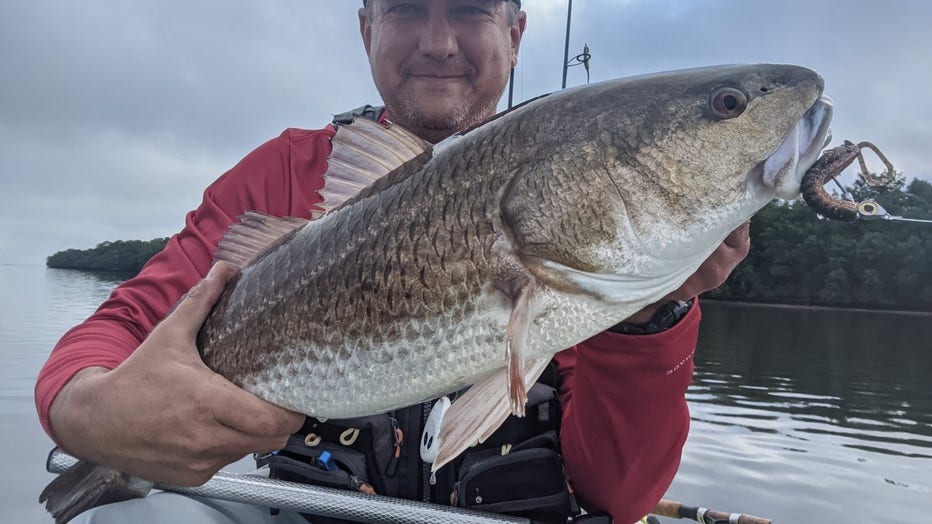
Redfish (Credit: Hubbard's Marina)
Residential dock lines are holding redfish too, especially at the points adjacent to flats, passes, and other areas that may concentrate bait and redfish. Slow-moving soft plastics, swimbaits, and slow jerk baits are working well for the redfish.
Also, live shrimp is always a great option this time of year along with the medium-sized whitebait if you can find it. Look for the mullet moving around the flats and often you will find numbers of redfish in tow behind the schools of mullet. You can also find them around the oyster bars when tides get high enough to let them forage the bars that get covered up by the water as they hunt for shrimp and other crustaceans.
Snook action has been a little slower this past week around the area overall, but some are still being caught around the flats. Also, creek and river mouths are becoming hot areas to look for the snook as well. They are holding to structures like residential docks, mangrove shorelines, or the drop-offs, cuts, or potholes around the flats.
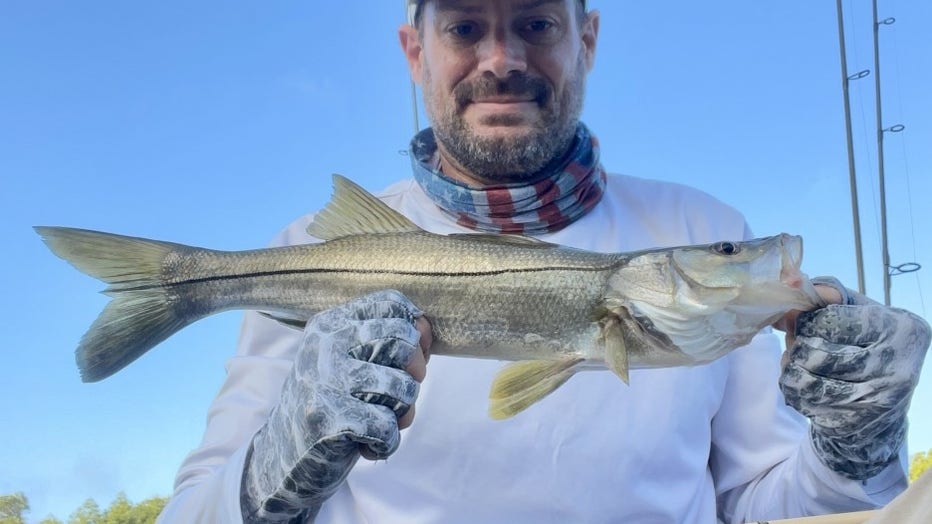
Snook (Credit: Hubbard's Marina)
You can find them cruising shorelines too. Soft plastics, top waters in low light conditions, and jerk baits are good options for artificials. The live bait they are loving right now is live shrimp, but whitebait is a great option if you can find it. Also, in deeper areas, small to medium pinfish work well for snook.
Trout action has been pretty good this past week around the flats, mangrove shorelines, dock lines, and even into the passes. They are more widespread right now and love soft plastics, artificial shrimp, and live shrimp too. Look for them with the lighter tackle, slower action rods due to their soft mouths, and target areas they can ambush passing baits with ease. These guys are pretty often stacked together on the drop-offs, down tide side of the bridges, piers, or docks or moving around on dock lights at night.
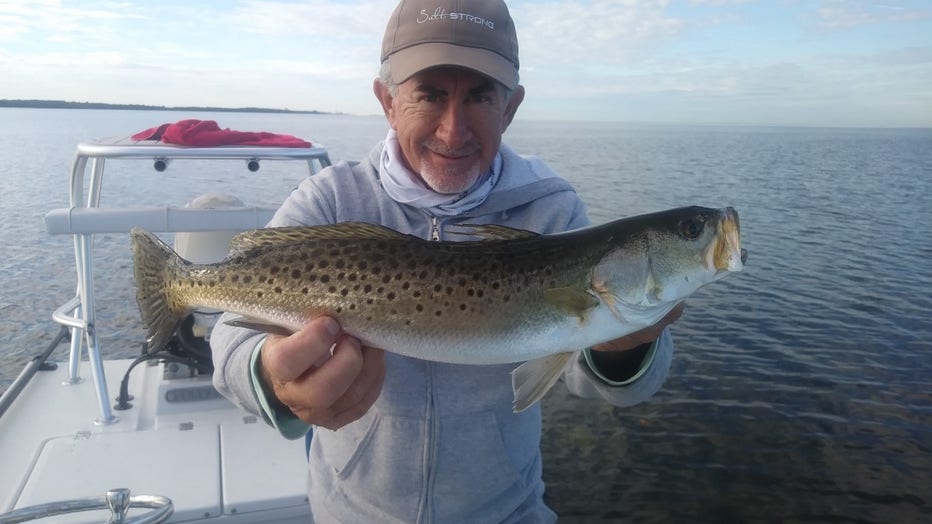
Trout (Credit: Hubbard's Marina)
Sheepshead are prolific through the area especially on or near structures where they can hunt for shrimp, crabs, and other crustaceans and mollusks. Residential dock lines are hot areas to hunt for sheepshead, especially in the back bay areas where waters are a little shallower and growth is abundant.
If you find a set of docks where there are lots of mangroves or adjacent to the flats you will find plentiful sheepshead. Local bridges and large docks are good places to look as well. Minimal weight and light tackle are needed to target the sheepshead too.
Flounder action has been spotty, but we are seeing more of them caught as of late. Look for them in the shadows of docks, bridges, or in the potholes of flats when fishing shallower. When deeper, look for them in the sandy areas where they can ambush baits down the tide of structures or ledges where the bottom depth drops off near flats, shorelines, or structures. They are often adjacent to rock piles or bigger structures in deeper waters too like around Tampa Bay.
Pompano are around our local passes and beaches and fishing piers. However, you have to get out there in the early morning and work those areas with the pompano jigs religiously to follow these fish around the area. You can find them on sandy areas adjacent to grass flats too but fishing along with the mouth of the bay, Fort De Soto area or local passes and bridges is most common.
Tripletail action is still around the area. We have seen a downward trend in the number of tripletail, but still, some are being caught. Look for them under floating debris, buoys, and around the markers of Tampa Bay. Even, occasionally, dock lights at night in the area with the right variables present will hold some tripletail.
Black drum are still around and most prevalent deeper into the back bay and intercoastal areas. We are seeing them around docks, bridges, and mangrove shorelines hunting for shrimp, crabs, or cut dead bait on the bottom. Fishing local bridges with cut crabs, big dead shrimp, or even cut threadfin are great ways to target them.
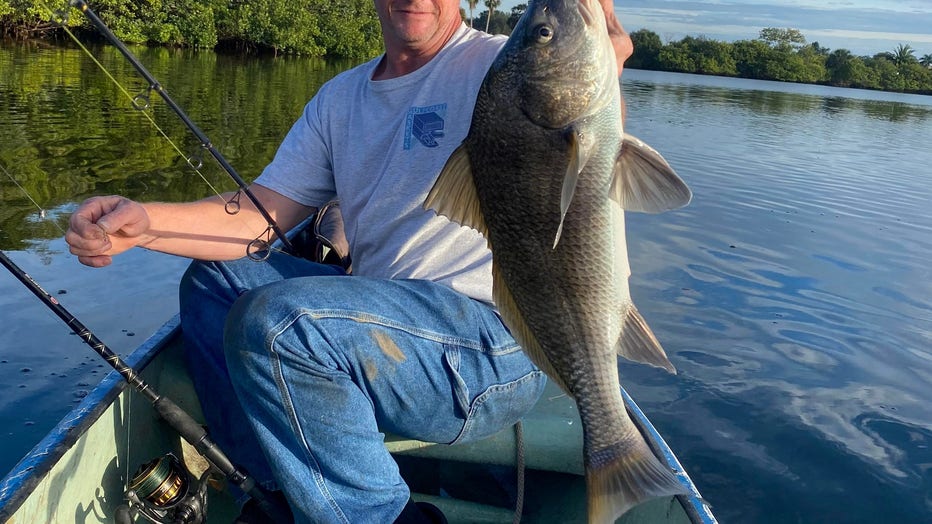
Black drum (Credit: Hubbard's Marina)
Near shore
Red grouper season is open and off to the races. We aren’t seeing a ton of them near shore right now with cooler waters, but you are able to find them when fishing the deeper near shore areas.
Look for them on the hard bottom areas, small ledges and potholes. Use things like longer strips of squid, smaller whole squid, butterflied baits, or even cut fillets of white grunts, squirrelfish, mullet, or mackerel. Anything nice and smelly (and/or oily) is a great option to target the red grouper near shore and even offshore too.
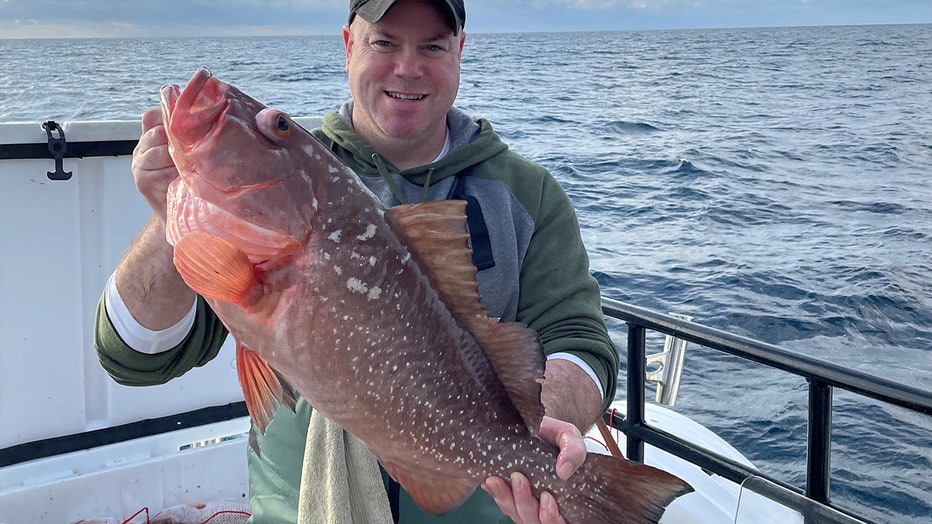
Red grouper (Credit: Hubbard's Marina)
We are typically fishing 40-60lb test with around a 5-6ot hook near shore when targeting red grouper with medium gear ratio conventional reels.
Lane snapper finally re-opened at the end of December. It will remain that way through the 2022 fishing year, hopefully. We are seeing some solid numbers of lane snapper near shore around 50 to 100 feet of water. Fishing at about 60 to 80 feet seems to be the sweet spot for seemingly never-ending lane snapper on squid chunks, cut threadfin, and live shrimp.
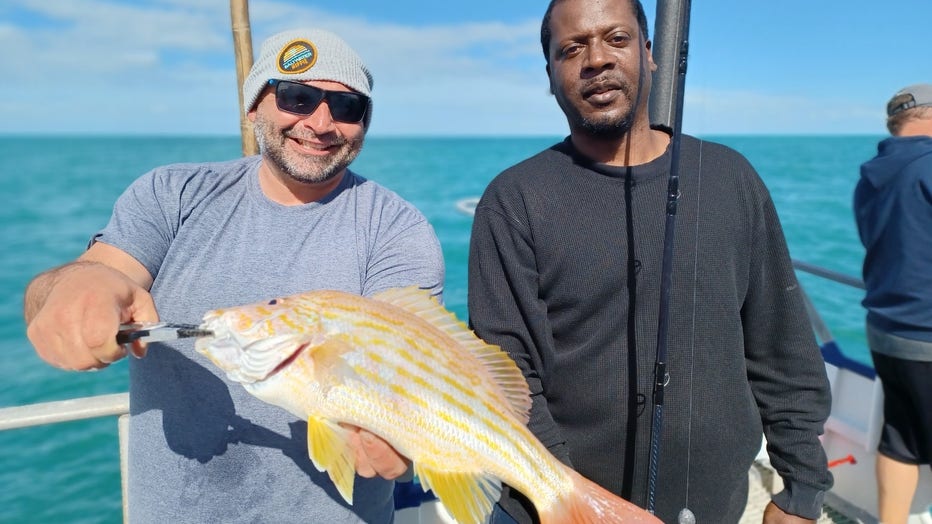
Lane snapper
Using around 30-40lb test and about a 3-4ot hook is a great way to target these great eating fish near shore.
Mangrove snapper are around near shore too. We aren’t seeing massive numbers or huge concentrations. However, the ones we do see seem to be very large for near shore mangrove snapper.
We are targeting them with cut threadfin and a double snell rig of 4ot hooks with 30-40lb leaders when fishing up to around 100 feet of water. However, we often get them as by catch when targeting hogfish in deeper hogfish areas like 60 to 80 feet. You can catch these guys as shallow as you want near shore, but they are most common the closer you get to 100ft of water in the deepest near shore areas.
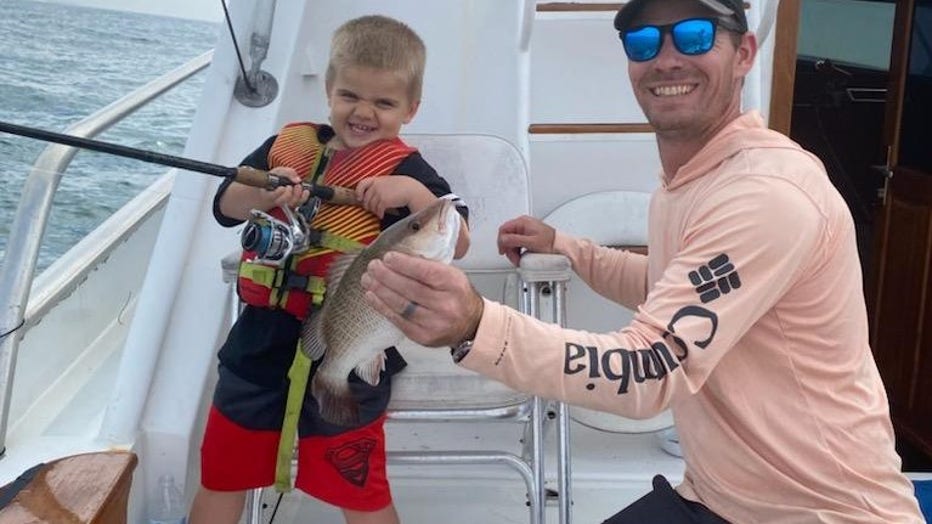
Mangrove snapper (Credit: Hubbard's Marina)
Kingfish are still around near shore but only in very select areas where bait is present and the conditions are right. We pick them up trolling out occasionally with the planners and spoons around 40 to 80 feet of water. There’s the occasional mackerel around still too, but numbers are definitely dwindling as water temps continue to downtrend.
Offshore
The red grouper bite was super-hot for us this past week as we transitioned from gag grouper fishing to the red grouper.
This past week, on our 12-hour extreme trip this past Wednesday, we caught a boat limit of keeper red grouper. That means everyone on board were completely limited out on keeper red grouper. We had them coming up on slow-pitch jigs two at a time while using live and dead bait too.
It didn’t much matter while at all the potholes, smaller ledges, bait shows, and hard bottom cuts, we saw plentiful red grouper action. Fishing around 160 to 200 feet of water is a great area to start targeting these plentiful and fat offshore red grouper.
Plus, while out deeper, targeting these red grouper we are seeing some nice scamp grouper too. The scamp bite has been steady offshore in deeper waters closer to that 200 feet area.
We are seeing them on the jigs, cut squid, and small to medium pinfish too. However, they are often caught while targeting mangrove snapper on cut threadfin using that double snell method.
Mangrove snapper action has been good offshore lately too. We are seeing these guys as shallow as we fish offshore up to that deeper 200 feet area. They are biting steadily and seemingly do best during the day in overcast conditions.
The double snell rig and cut threadfin are the go-to options for targeting mangrove snapper with 30-40lb leaders and a fast gear ratioed reel. Using a rod with a super sensitive and lighter rod tip and decent backbone is the way to go when targeting these fast-biting and smart mangrove snapper.
We are still seeing plentiful porgies, vermillion, almacos, and occasionally yellowtail snapper while offshore targeting the red grouper, scamp, and mangroves. Plenty of heads and tails while offshore fishing -- especially as we go deeper, the bigger we see the plentiful vermillion snapper.
At our fisheries meetings this week, the council is discussing severely increasing the vermillion snapper catch limits as fishery scientists have recorded the largest vermillion snapper recruitment ever recorded.
This means we should see a huge influx of those keeper-sized vermillions entering the fishery and a healthy fishery for years to come!
Pelagic action out deep is very hit or miss, but we are seeing the blackfin tuna, kingfish and wahoo while out fishing deeper waters. Trolling the nomad DTX minnows, Nomad Madmacs, or the Rapala Xrap Magnums are the go to lures we use on our deepwater trolling setups.
However, the dredges, plugs, and skirts are all working well. Wahoo love the darker colors like purples, blacks, and dark blues. The redhead, white body classic color pattern is a good option always too!
Don't be a fool; bring a venting tool and/or a descending device
It is so important to keep in mind the importance of dead discards and discard mortality when engaged in near shore or offshore fishing. If we can all work together to change the cultural norms near shore and offshore, we can all help to improve our fishery and our fishery access over time.
How many do you know right now that are all for catching and releasing snook, redfish, and trout but will be the first in line to kill a mangrove snapper, gag grouper or red snapper and the attitude completely changes when discussing these offshore species?
Plus, the same person inshore that will hold their breath and wet their hands before handling a breeder snook will go offshore and then cull through 20 red snappers before keeper their two red snapper they deem large enough to fill their two-fish bag limits while the other 18 they released will often end up suffering fatal damage if not properly descended or vented?
Please help us to spread the word on the importance of descending or venting your released fish. Descending devices are most easy to use and quick to pick up on their use and are most effective for most anglers. However, an expert and precise angler with proper training and tons of experience can use a venting tool properly with similar outcomes. However, a venting tool requires you to pierce the fish while most descending devices are much less invasive.
While using a venting tool it is imperative you pierce them in the exact right spot, and you do not go but a quarter-inch or less in the fish. Most venting tools require you to ‘choke up’ on the tool to prevent over-penetration into major organs.
When fishing deep water, especially in the sweltering summer months, please make sure to treat all fish intended to be released like that breeder snook inshore and minimize the time it takes you to get him from the bottom to the boat using heavier proper tackle not an ultra-light spinning reel. Then once onboard, minimize the time out of the water. Then use a proper dehooking tool, and then for the love of God, use a descending device or venting tool PROPERLY to ensure that fish has a chance to live another day.
Three things will help ensure the survivability of those fish released offshore.
- Making sure they are brought up quickly and do not expend all their energy in the fight.
- Make sure they are unhooked smoothly, easily, and as quickly as possible.
- Finally, make sure they spend the least amount of time at the surface at negative pressures where barotrauma exponentially increases its effect with each passing second.
Also, keep in mind when the water is warm there is less dissolved oxygen content, and the chances of barotrauma increase even more while its effects can be even more deadly.
CHECK OUT THE NEW WEBSITE and marketing campaign to get your own FREE descending device and more information on mitigating barotrauma and barotrauma issues! Do not forget to use the hashtag #ReturnEmRight to help spread the word too on fish you catch and release offshore -> https://returnemright.org/
State survey to improve recreational data and access
It is imperative that you have your gulf reef fish survey endorsement on your fishing license if you are a private recreational angler or diver fishing from a private boat anywhere in Florida who intends to harvest, attempt to harvest or possess one or more of the following reef fish species: mutton snapper, yellowtail snapper, hogfish, red snapper, vermilion snapper, gag grouper, red grouper, black grouper, greater amberjack, lesser amberjack, banded rudderfish, almaco jack, gray triggerfish, Gag grouper, Red grouper, Scamp grouper, Mangrove snapper, Lane snapper, Kingfish, Tuna, or Mahi mahi.
Here is all the information and more on that program and how you can sign up -> https://myfwc.com/fishing/saltwater/recreational/state-reef-fish-survey/
TERMS OF REFERENCE:
INSHORE – from the back bays out to the bridges and including right on the beaches
NEAR SHORE – From the beaches out to 20 miles, or up to 100ft of water
OFFSHORE – from 20 miles or 100ft and beyond
For more fishing reports, photos, videos and more check out Hubbard’s Marina on Facebook, Instagram, YouTube, or Snapchat. Just simply search "HubbardsMarina" and do not forget our family motto, "If you’re too busy to go fishing, you’re just too busy!

